Organisation Behaviour: Power, Culture, Politics and Motivation
VerifiedAdded on 2023/06/13
|15
|5000
|212
Report
AI Summary
This report provides a comprehensive analysis of organisation behaviour, focusing on the interconnectedness of power, culture, politics, and motivation within Procter & Gamble (P&G). It examines how these elements impact individual and team performance, drawing upon models like Handy's cultural model and Maslow's hierarchy of needs. The report critically evaluates the positive and negative effects of organisational politics, the influence of different types of power, and the application of motivation theories, including content and process theories. Furthermore, it reviews the relevance of team development theories and explores the characteristics of effective versus ineffective teams, concluding with an evaluation of key concepts and philosophies of organisation behaviour in the context of achieving organisational goals at P&G.
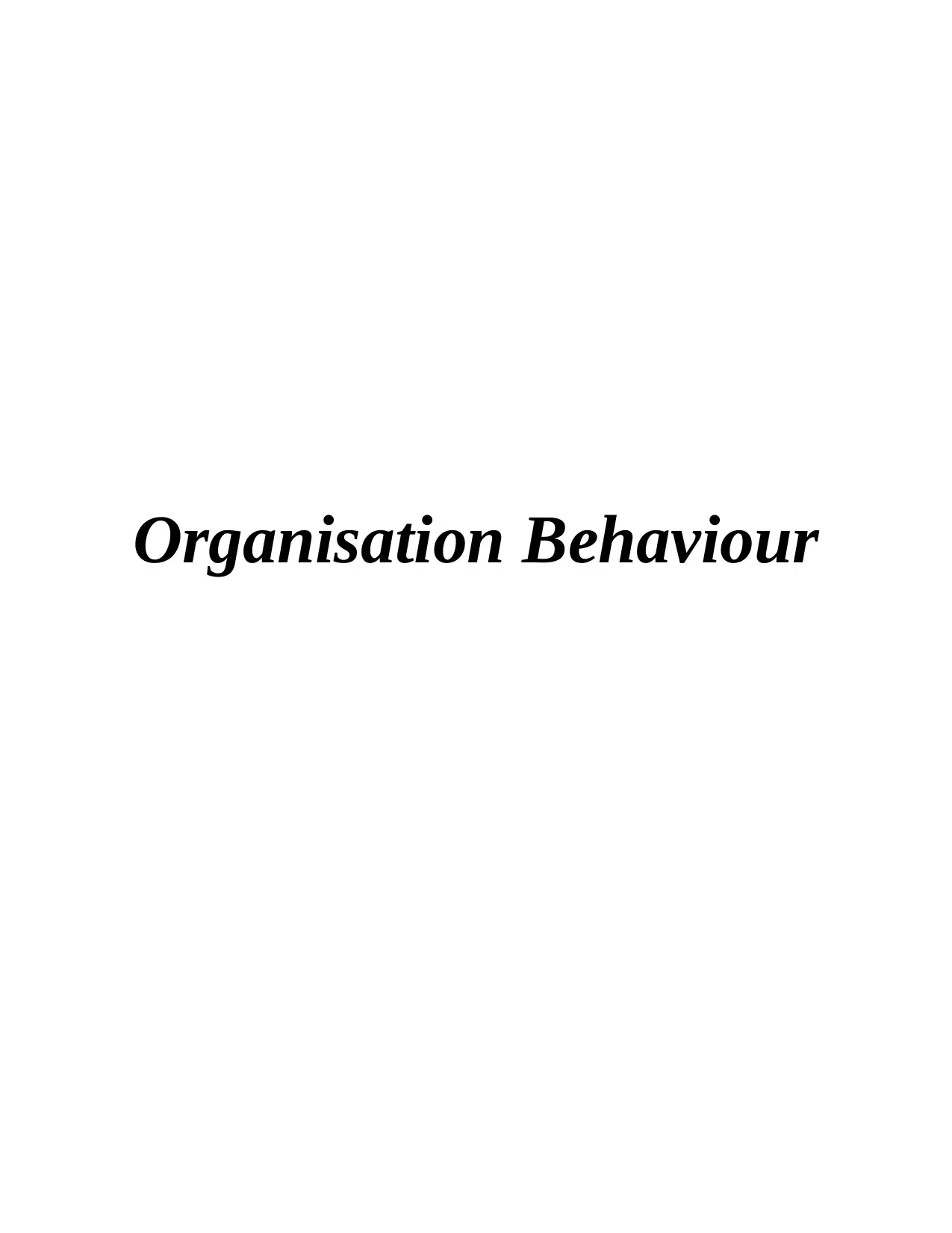
Organisation Behaviour
Paraphrase This Document
Need a fresh take? Get an instant paraphrase of this document with our AI Paraphraser
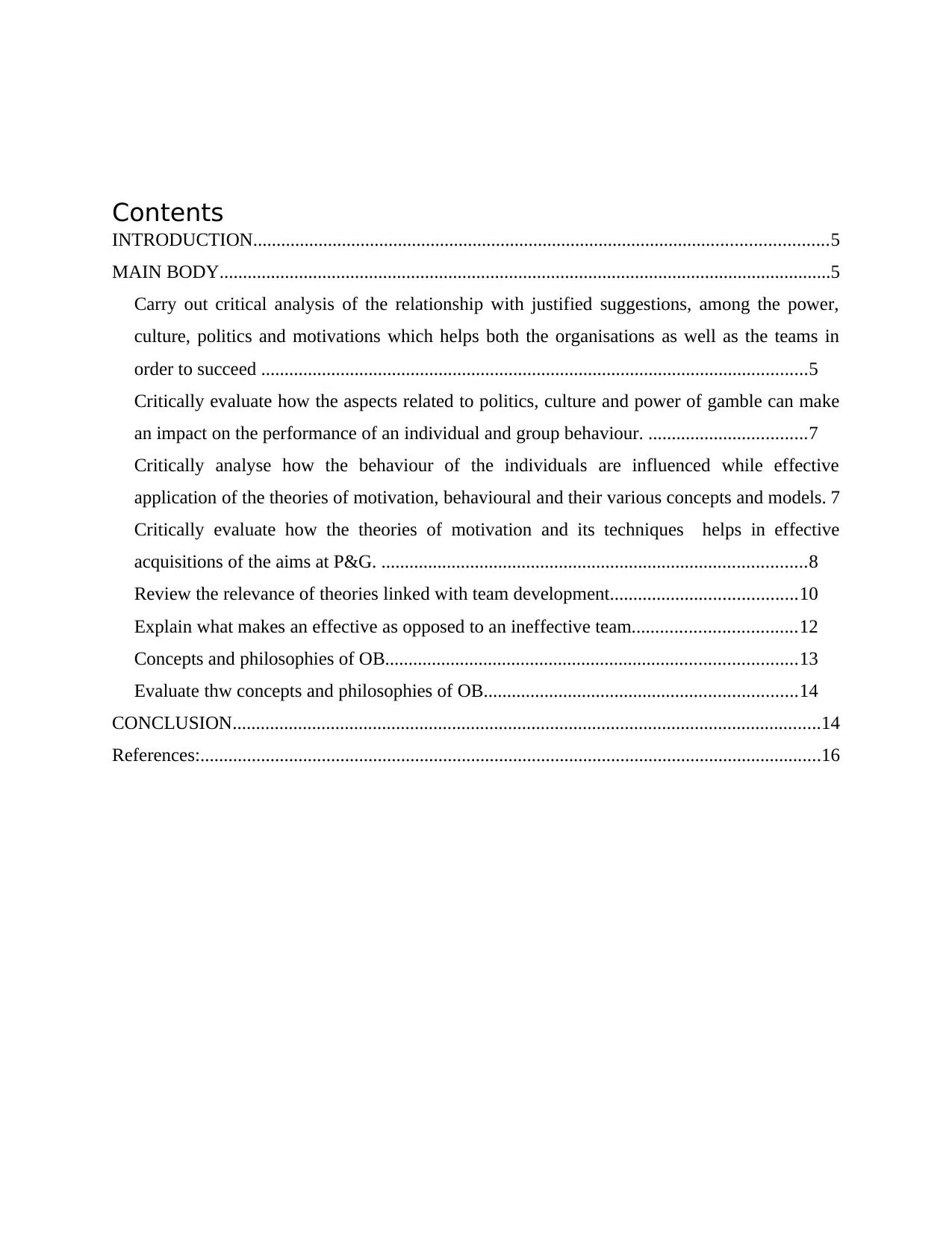
Contents
INTRODUCTION...........................................................................................................................5
MAIN BODY...................................................................................................................................5
Carry out critical analysis of the relationship with justified suggestions, among the power,
culture, politics and motivations which helps both the organisations as well as the teams in
order to succeed .....................................................................................................................5
Critically evaluate how the aspects related to politics, culture and power of gamble can make
an impact on the performance of an individual and group behaviour. ..................................7
Critically analyse how the behaviour of the individuals are influenced while effective
application of the theories of motivation, behavioural and their various concepts and models. 7
Critically evaluate how the theories of motivation and its techniques helps in effective
acquisitions of the aims at P&G. ...........................................................................................8
Review the relevance of theories linked with team development........................................10
Explain what makes an effective as opposed to an ineffective team...................................12
Concepts and philosophies of OB........................................................................................13
Evaluate thw concepts and philosophies of OB...................................................................14
CONCLUSION..............................................................................................................................14
References:.....................................................................................................................................16
INTRODUCTION...........................................................................................................................5
MAIN BODY...................................................................................................................................5
Carry out critical analysis of the relationship with justified suggestions, among the power,
culture, politics and motivations which helps both the organisations as well as the teams in
order to succeed .....................................................................................................................5
Critically evaluate how the aspects related to politics, culture and power of gamble can make
an impact on the performance of an individual and group behaviour. ..................................7
Critically analyse how the behaviour of the individuals are influenced while effective
application of the theories of motivation, behavioural and their various concepts and models. 7
Critically evaluate how the theories of motivation and its techniques helps in effective
acquisitions of the aims at P&G. ...........................................................................................8
Review the relevance of theories linked with team development........................................10
Explain what makes an effective as opposed to an ineffective team...................................12
Concepts and philosophies of OB........................................................................................13
Evaluate thw concepts and philosophies of OB...................................................................14
CONCLUSION..............................................................................................................................14
References:.....................................................................................................................................16
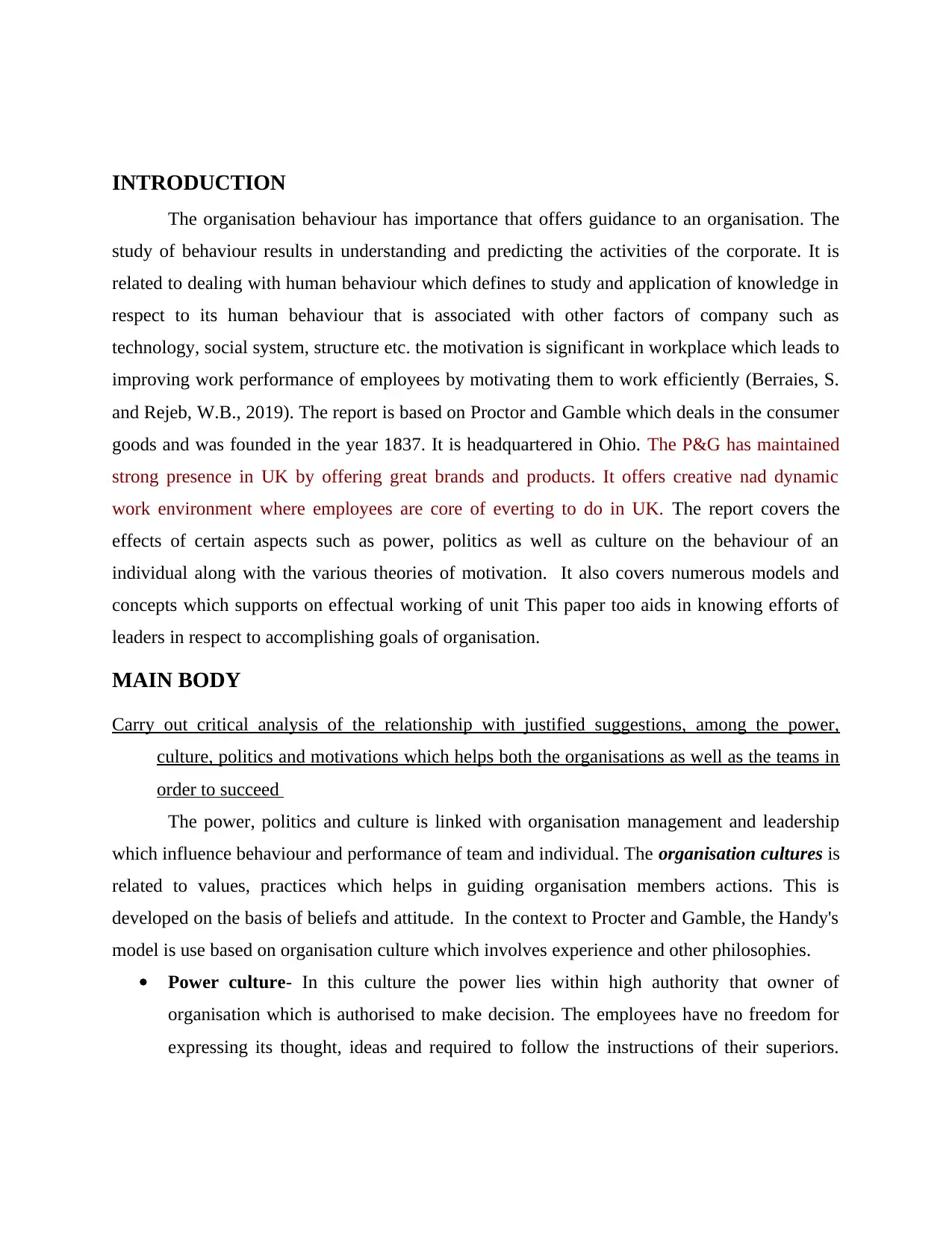
INTRODUCTION
The organisation behaviour has importance that offers guidance to an organisation. The
study of behaviour results in understanding and predicting the activities of the corporate. It is
related to dealing with human behaviour which defines to study and application of knowledge in
respect to its human behaviour that is associated with other factors of company such as
technology, social system, structure etc. the motivation is significant in workplace which leads to
improving work performance of employees by motivating them to work efficiently (Berraies, S.
and Rejeb, W.B., 2019). The report is based on Proctor and Gamble which deals in the consumer
goods and was founded in the year 1837. It is headquartered in Ohio. The P&G has maintained
strong presence in UK by offering great brands and products. It offers creative nad dynamic
work environment where employees are core of everting to do in UK. The report covers the
effects of certain aspects such as power, politics as well as culture on the behaviour of an
individual along with the various theories of motivation. It also covers numerous models and
concepts which supports on effectual working of unit This paper too aids in knowing efforts of
leaders in respect to accomplishing goals of organisation.
MAIN BODY
Carry out critical analysis of the relationship with justified suggestions, among the power,
culture, politics and motivations which helps both the organisations as well as the teams in
order to succeed
The power, politics and culture is linked with organisation management and leadership
which influence behaviour and performance of team and individual. The organisation cultures is
related to values, practices which helps in guiding organisation members actions. This is
developed on the basis of beliefs and attitude. In the context to Procter and Gamble, the Handy's
model is use based on organisation culture which involves experience and other philosophies.
Power culture- In this culture the power lies within high authority that owner of
organisation which is authorised to make decision. The employees have no freedom for
expressing its thought, ideas and required to follow the instructions of their superiors.
The organisation behaviour has importance that offers guidance to an organisation. The
study of behaviour results in understanding and predicting the activities of the corporate. It is
related to dealing with human behaviour which defines to study and application of knowledge in
respect to its human behaviour that is associated with other factors of company such as
technology, social system, structure etc. the motivation is significant in workplace which leads to
improving work performance of employees by motivating them to work efficiently (Berraies, S.
and Rejeb, W.B., 2019). The report is based on Proctor and Gamble which deals in the consumer
goods and was founded in the year 1837. It is headquartered in Ohio. The P&G has maintained
strong presence in UK by offering great brands and products. It offers creative nad dynamic
work environment where employees are core of everting to do in UK. The report covers the
effects of certain aspects such as power, politics as well as culture on the behaviour of an
individual along with the various theories of motivation. It also covers numerous models and
concepts which supports on effectual working of unit This paper too aids in knowing efforts of
leaders in respect to accomplishing goals of organisation.
MAIN BODY
Carry out critical analysis of the relationship with justified suggestions, among the power,
culture, politics and motivations which helps both the organisations as well as the teams in
order to succeed
The power, politics and culture is linked with organisation management and leadership
which influence behaviour and performance of team and individual. The organisation cultures is
related to values, practices which helps in guiding organisation members actions. This is
developed on the basis of beliefs and attitude. In the context to Procter and Gamble, the Handy's
model is use based on organisation culture which involves experience and other philosophies.
Power culture- In this culture the power lies within high authority that owner of
organisation which is authorised to make decision. The employees have no freedom for
expressing its thought, ideas and required to follow the instructions of their superiors.
⊘ This is a preview!⊘
Do you want full access?
Subscribe today to unlock all pages.

Trusted by 1+ million students worldwide
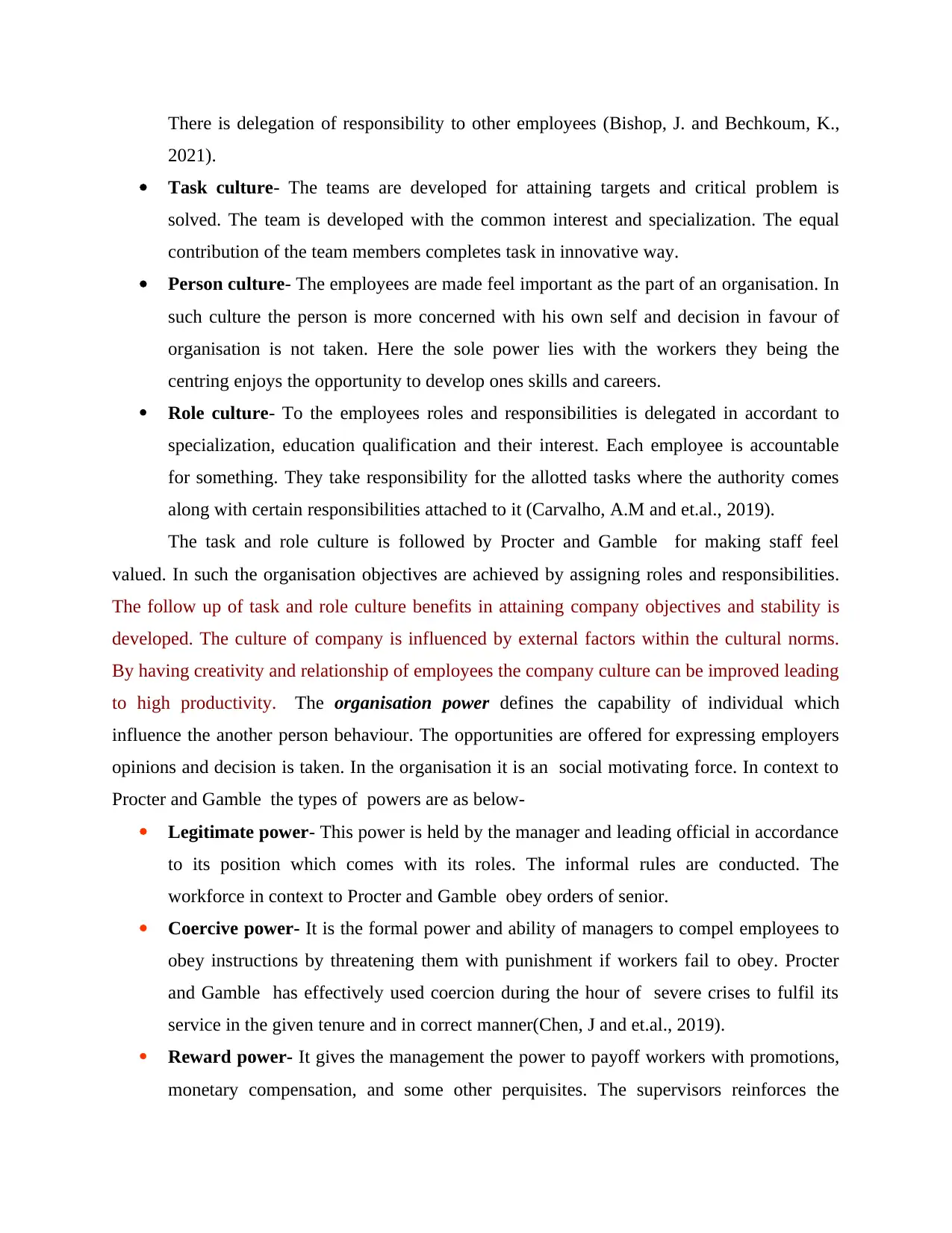
There is delegation of responsibility to other employees (Bishop, J. and Bechkoum, K.,
2021).
Task culture- The teams are developed for attaining targets and critical problem is
solved. The team is developed with the common interest and specialization. The equal
contribution of the team members completes task in innovative way.
Person culture- The employees are made feel important as the part of an organisation. In
such culture the person is more concerned with his own self and decision in favour of
organisation is not taken. Here the sole power lies with the workers they being the
centring enjoys the opportunity to develop ones skills and careers.
Role culture- To the employees roles and responsibilities is delegated in accordant to
specialization, education qualification and their interest. Each employee is accountable
for something. They take responsibility for the allotted tasks where the authority comes
along with certain responsibilities attached to it (Carvalho, A.M and et.al., 2019).
The task and role culture is followed by Procter and Gamble for making staff feel
valued. In such the organisation objectives are achieved by assigning roles and responsibilities.
The follow up of task and role culture benefits in attaining company objectives and stability is
developed. The culture of company is influenced by external factors within the cultural norms.
By having creativity and relationship of employees the company culture can be improved leading
to high productivity. The organisation power defines the capability of individual which
influence the another person behaviour. The opportunities are offered for expressing employers
opinions and decision is taken. In the organisation it is an social motivating force. In context to
Procter and Gamble the types of powers are as below-
Legitimate power- This power is held by the manager and leading official in accordance
to its position which comes with its roles. The informal rules are conducted. The
workforce in context to Procter and Gamble obey orders of senior.
Coercive power- It is the formal power and ability of managers to compel employees to
obey instructions by threatening them with punishment if workers fail to obey. Procter
and Gamble has effectively used coercion during the hour of severe crises to fulfil its
service in the given tenure and in correct manner(Chen, J and et.al., 2019).
Reward power- It gives the management the power to payoff workers with promotions,
monetary compensation, and some other perquisites. The supervisors reinforces the
2021).
Task culture- The teams are developed for attaining targets and critical problem is
solved. The team is developed with the common interest and specialization. The equal
contribution of the team members completes task in innovative way.
Person culture- The employees are made feel important as the part of an organisation. In
such culture the person is more concerned with his own self and decision in favour of
organisation is not taken. Here the sole power lies with the workers they being the
centring enjoys the opportunity to develop ones skills and careers.
Role culture- To the employees roles and responsibilities is delegated in accordant to
specialization, education qualification and their interest. Each employee is accountable
for something. They take responsibility for the allotted tasks where the authority comes
along with certain responsibilities attached to it (Carvalho, A.M and et.al., 2019).
The task and role culture is followed by Procter and Gamble for making staff feel
valued. In such the organisation objectives are achieved by assigning roles and responsibilities.
The follow up of task and role culture benefits in attaining company objectives and stability is
developed. The culture of company is influenced by external factors within the cultural norms.
By having creativity and relationship of employees the company culture can be improved leading
to high productivity. The organisation power defines the capability of individual which
influence the another person behaviour. The opportunities are offered for expressing employers
opinions and decision is taken. In the organisation it is an social motivating force. In context to
Procter and Gamble the types of powers are as below-
Legitimate power- This power is held by the manager and leading official in accordance
to its position which comes with its roles. The informal rules are conducted. The
workforce in context to Procter and Gamble obey orders of senior.
Coercive power- It is the formal power and ability of managers to compel employees to
obey instructions by threatening them with punishment if workers fail to obey. Procter
and Gamble has effectively used coercion during the hour of severe crises to fulfil its
service in the given tenure and in correct manner(Chen, J and et.al., 2019).
Reward power- It gives the management the power to payoff workers with promotions,
monetary compensation, and some other perquisites. The supervisors reinforces the
Paraphrase This Document
Need a fresh take? Get an instant paraphrase of this document with our AI Paraphraser
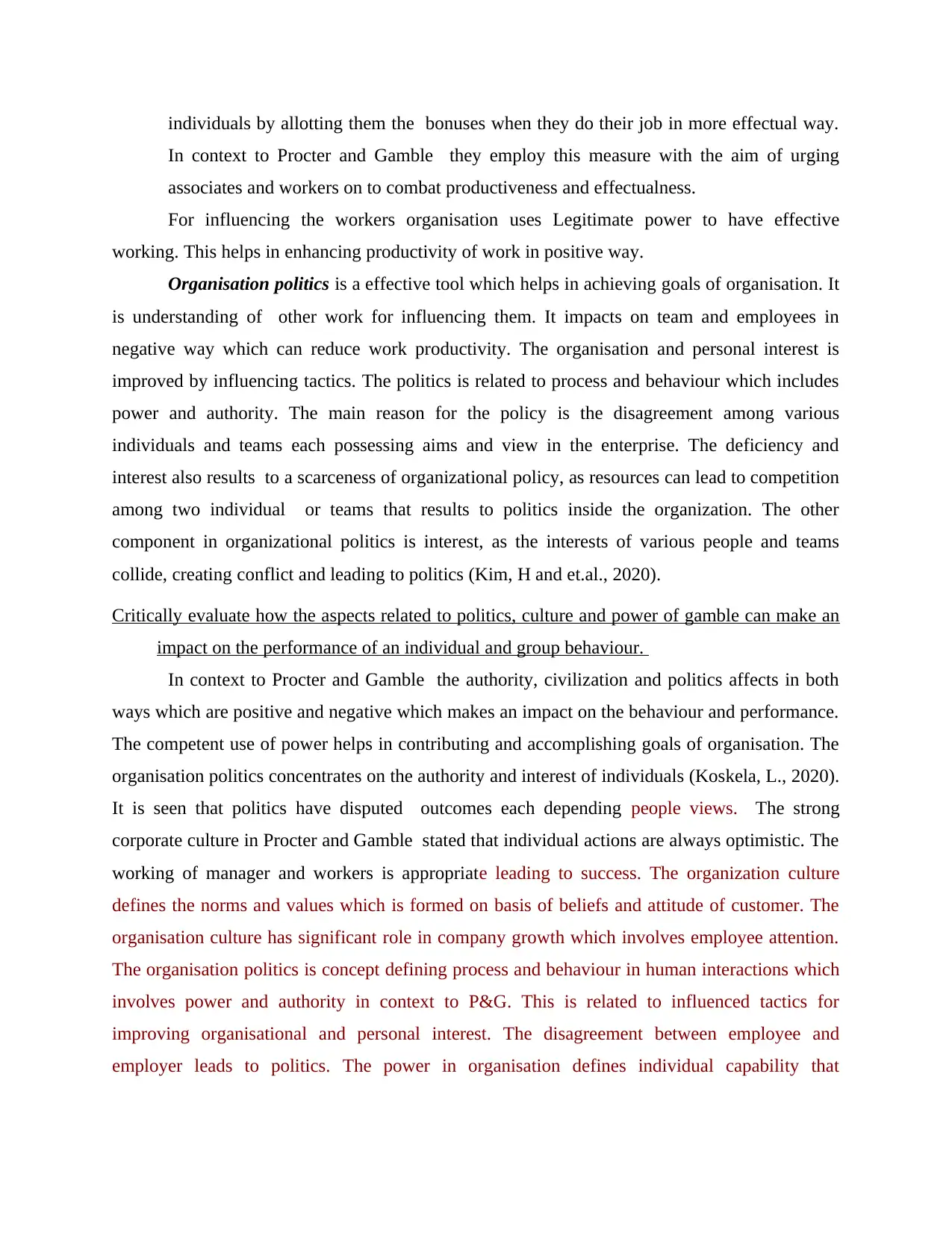
individuals by allotting them the bonuses when they do their job in more effectual way.
In context to Procter and Gamble they employ this measure with the aim of urging
associates and workers on to combat productiveness and effectualness.
For influencing the workers organisation uses Legitimate power to have effective
working. This helps in enhancing productivity of work in positive way.
Organisation politics is a effective tool which helps in achieving goals of organisation. It
is understanding of other work for influencing them. It impacts on team and employees in
negative way which can reduce work productivity. The organisation and personal interest is
improved by influencing tactics. The politics is related to process and behaviour which includes
power and authority. The main reason for the policy is the disagreement among various
individuals and teams each possessing aims and view in the enterprise. The deficiency and
interest also results to a scarceness of organizational policy, as resources can lead to competition
among two individual or teams that results to politics inside the organization. The other
component in organizational politics is interest, as the interests of various people and teams
collide, creating conflict and leading to politics (Kim, H and et.al., 2020).
Critically evaluate how the aspects related to politics, culture and power of gamble can make an
impact on the performance of an individual and group behaviour.
In context to Procter and Gamble the authority, civilization and politics affects in both
ways which are positive and negative which makes an impact on the behaviour and performance.
The competent use of power helps in contributing and accomplishing goals of organisation. The
organisation politics concentrates on the authority and interest of individuals (Koskela, L., 2020).
It is seen that politics have disputed outcomes each depending people views. The strong
corporate culture in Procter and Gamble stated that individual actions are always optimistic. The
working of manager and workers is appropriate leading to success. The organization culture
defines the norms and values which is formed on basis of beliefs and attitude of customer. The
organisation culture has significant role in company growth which involves employee attention.
The organisation politics is concept defining process and behaviour in human interactions which
involves power and authority in context to P&G. This is related to influenced tactics for
improving organisational and personal interest. The disagreement between employee and
employer leads to politics. The power in organisation defines individual capability that
In context to Procter and Gamble they employ this measure with the aim of urging
associates and workers on to combat productiveness and effectualness.
For influencing the workers organisation uses Legitimate power to have effective
working. This helps in enhancing productivity of work in positive way.
Organisation politics is a effective tool which helps in achieving goals of organisation. It
is understanding of other work for influencing them. It impacts on team and employees in
negative way which can reduce work productivity. The organisation and personal interest is
improved by influencing tactics. The politics is related to process and behaviour which includes
power and authority. The main reason for the policy is the disagreement among various
individuals and teams each possessing aims and view in the enterprise. The deficiency and
interest also results to a scarceness of organizational policy, as resources can lead to competition
among two individual or teams that results to politics inside the organization. The other
component in organizational politics is interest, as the interests of various people and teams
collide, creating conflict and leading to politics (Kim, H and et.al., 2020).
Critically evaluate how the aspects related to politics, culture and power of gamble can make an
impact on the performance of an individual and group behaviour.
In context to Procter and Gamble the authority, civilization and politics affects in both
ways which are positive and negative which makes an impact on the behaviour and performance.
The competent use of power helps in contributing and accomplishing goals of organisation. The
organisation politics concentrates on the authority and interest of individuals (Koskela, L., 2020).
It is seen that politics have disputed outcomes each depending people views. The strong
corporate culture in Procter and Gamble stated that individual actions are always optimistic. The
working of manager and workers is appropriate leading to success. The organization culture
defines the norms and values which is formed on basis of beliefs and attitude of customer. The
organisation culture has significant role in company growth which involves employee attention.
The organisation politics is concept defining process and behaviour in human interactions which
involves power and authority in context to P&G. This is related to influenced tactics for
improving organisational and personal interest. The disagreement between employee and
employer leads to politics. The power in organisation defines individual capability that
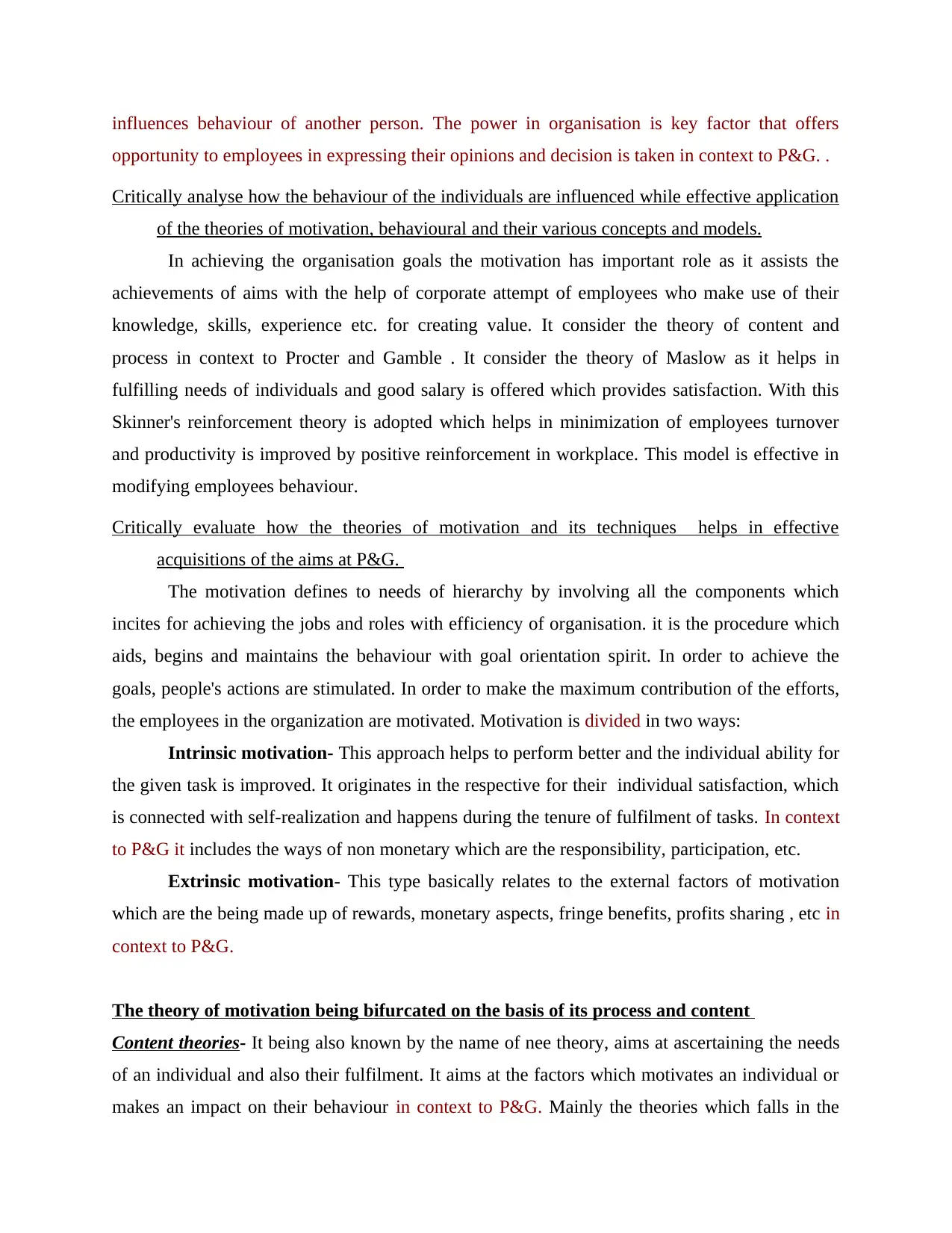
influences behaviour of another person. The power in organisation is key factor that offers
opportunity to employees in expressing their opinions and decision is taken in context to P&G. .
Critically analyse how the behaviour of the individuals are influenced while effective application
of the theories of motivation, behavioural and their various concepts and models.
In achieving the organisation goals the motivation has important role as it assists the
achievements of aims with the help of corporate attempt of employees who make use of their
knowledge, skills, experience etc. for creating value. It consider the theory of content and
process in context to Procter and Gamble . It consider the theory of Maslow as it helps in
fulfilling needs of individuals and good salary is offered which provides satisfaction. With this
Skinner's reinforcement theory is adopted which helps in minimization of employees turnover
and productivity is improved by positive reinforcement in workplace. This model is effective in
modifying employees behaviour.
Critically evaluate how the theories of motivation and its techniques helps in effective
acquisitions of the aims at P&G.
The motivation defines to needs of hierarchy by involving all the components which
incites for achieving the jobs and roles with efficiency of organisation. it is the procedure which
aids, begins and maintains the behaviour with goal orientation spirit. In order to achieve the
goals, people's actions are stimulated. In order to make the maximum contribution of the efforts,
the employees in the organization are motivated. Motivation is divided in two ways:
Intrinsic motivation- This approach helps to perform better and the individual ability for
the given task is improved. It originates in the respective for their individual satisfaction, which
is connected with self-realization and happens during the tenure of fulfilment of tasks. In context
to P&G it includes the ways of non monetary which are the responsibility, participation, etc.
Extrinsic motivation- This type basically relates to the external factors of motivation
which are the being made up of rewards, monetary aspects, fringe benefits, profits sharing , etc in
context to P&G.
The theory of motivation being bifurcated on the basis of its process and content
Content theories- It being also known by the name of nee theory, aims at ascertaining the needs
of an individual and also their fulfilment. It aims at the factors which motivates an individual or
makes an impact on their behaviour in context to P&G. Mainly the theories which falls in the
opportunity to employees in expressing their opinions and decision is taken in context to P&G. .
Critically analyse how the behaviour of the individuals are influenced while effective application
of the theories of motivation, behavioural and their various concepts and models.
In achieving the organisation goals the motivation has important role as it assists the
achievements of aims with the help of corporate attempt of employees who make use of their
knowledge, skills, experience etc. for creating value. It consider the theory of content and
process in context to Procter and Gamble . It consider the theory of Maslow as it helps in
fulfilling needs of individuals and good salary is offered which provides satisfaction. With this
Skinner's reinforcement theory is adopted which helps in minimization of employees turnover
and productivity is improved by positive reinforcement in workplace. This model is effective in
modifying employees behaviour.
Critically evaluate how the theories of motivation and its techniques helps in effective
acquisitions of the aims at P&G.
The motivation defines to needs of hierarchy by involving all the components which
incites for achieving the jobs and roles with efficiency of organisation. it is the procedure which
aids, begins and maintains the behaviour with goal orientation spirit. In order to achieve the
goals, people's actions are stimulated. In order to make the maximum contribution of the efforts,
the employees in the organization are motivated. Motivation is divided in two ways:
Intrinsic motivation- This approach helps to perform better and the individual ability for
the given task is improved. It originates in the respective for their individual satisfaction, which
is connected with self-realization and happens during the tenure of fulfilment of tasks. In context
to P&G it includes the ways of non monetary which are the responsibility, participation, etc.
Extrinsic motivation- This type basically relates to the external factors of motivation
which are the being made up of rewards, monetary aspects, fringe benefits, profits sharing , etc in
context to P&G.
The theory of motivation being bifurcated on the basis of its process and content
Content theories- It being also known by the name of nee theory, aims at ascertaining the needs
of an individual and also their fulfilment. It aims at the factors which motivates an individual or
makes an impact on their behaviour in context to P&G. Mainly the theories which falls in the
⊘ This is a preview!⊘
Do you want full access?
Subscribe today to unlock all pages.

Trusted by 1+ million students worldwide
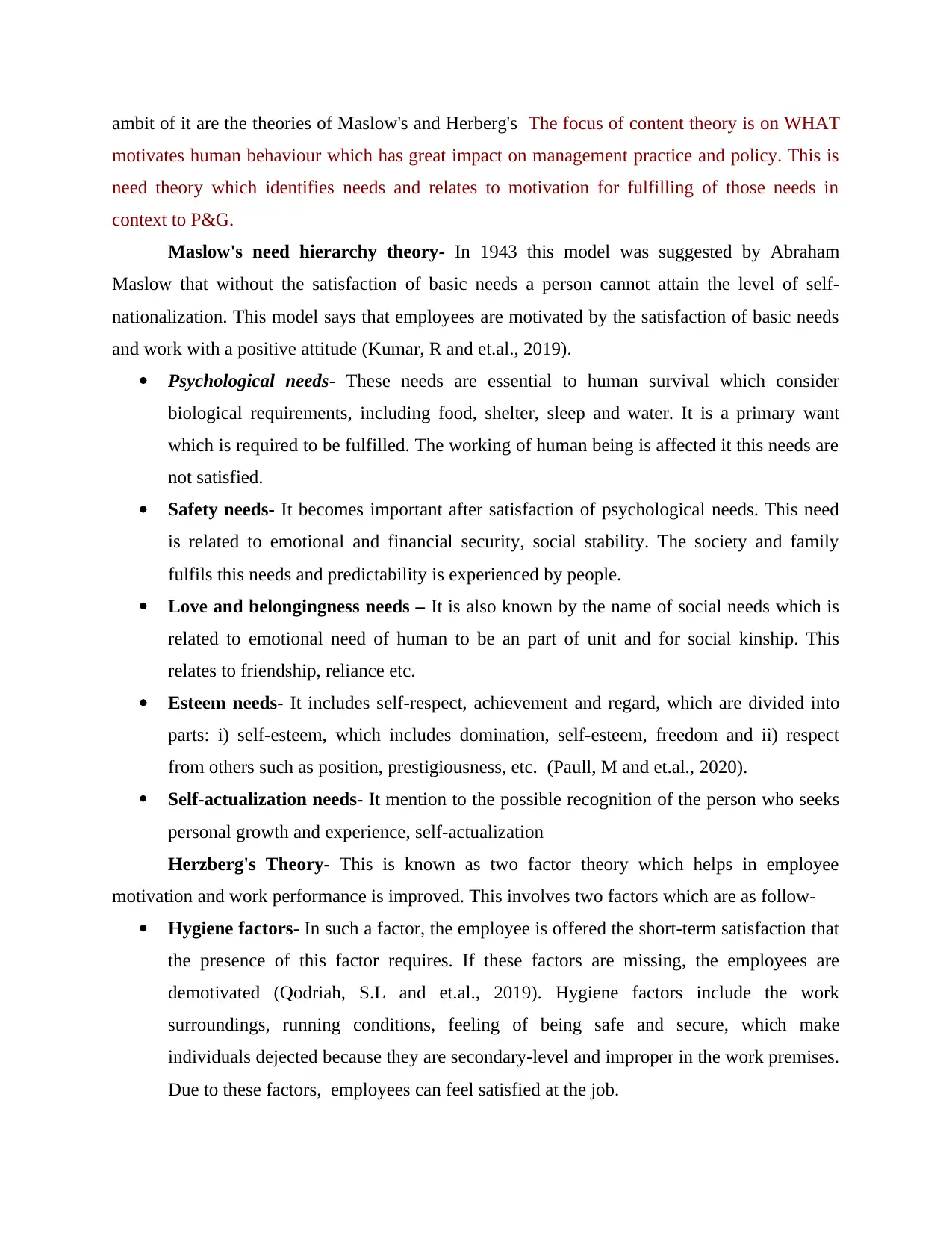
ambit of it are the theories of Maslow's and Herberg's The focus of content theory is on WHAT
motivates human behaviour which has great impact on management practice and policy. This is
need theory which identifies needs and relates to motivation for fulfilling of those needs in
context to P&G.
Maslow's need hierarchy theory- In 1943 this model was suggested by Abraham
Maslow that without the satisfaction of basic needs a person cannot attain the level of self-
nationalization. This model says that employees are motivated by the satisfaction of basic needs
and work with a positive attitude (Kumar, R and et.al., 2019).
Psychological needs- These needs are essential to human survival which consider
biological requirements, including food, shelter, sleep and water. It is a primary want
which is required to be fulfilled. The working of human being is affected it this needs are
not satisfied.
Safety needs- It becomes important after satisfaction of psychological needs. This need
is related to emotional and financial security, social stability. The society and family
fulfils this needs and predictability is experienced by people.
Love and belongingness needs – It is also known by the name of social needs which is
related to emotional need of human to be an part of unit and for social kinship. This
relates to friendship, reliance etc.
Esteem needs- It includes self-respect, achievement and regard, which are divided into
parts: i) self-esteem, which includes domination, self-esteem, freedom and ii) respect
from others such as position, prestigiousness, etc. (Paull, M and et.al., 2020).
Self-actualization needs- It mention to the possible recognition of the person who seeks
personal growth and experience, self-actualization
Herzberg's Theory- This is known as two factor theory which helps in employee
motivation and work performance is improved. This involves two factors which are as follow-
Hygiene factors- In such a factor, the employee is offered the short-term satisfaction that
the presence of this factor requires. If these factors are missing, the employees are
demotivated (Qodriah, S.L and et.al., 2019). Hygiene factors include the work
surroundings, running conditions, feeling of being safe and secure, which make
individuals dejected because they are secondary-level and improper in the work premises.
Due to these factors, employees can feel satisfied at the job.
motivates human behaviour which has great impact on management practice and policy. This is
need theory which identifies needs and relates to motivation for fulfilling of those needs in
context to P&G.
Maslow's need hierarchy theory- In 1943 this model was suggested by Abraham
Maslow that without the satisfaction of basic needs a person cannot attain the level of self-
nationalization. This model says that employees are motivated by the satisfaction of basic needs
and work with a positive attitude (Kumar, R and et.al., 2019).
Psychological needs- These needs are essential to human survival which consider
biological requirements, including food, shelter, sleep and water. It is a primary want
which is required to be fulfilled. The working of human being is affected it this needs are
not satisfied.
Safety needs- It becomes important after satisfaction of psychological needs. This need
is related to emotional and financial security, social stability. The society and family
fulfils this needs and predictability is experienced by people.
Love and belongingness needs – It is also known by the name of social needs which is
related to emotional need of human to be an part of unit and for social kinship. This
relates to friendship, reliance etc.
Esteem needs- It includes self-respect, achievement and regard, which are divided into
parts: i) self-esteem, which includes domination, self-esteem, freedom and ii) respect
from others such as position, prestigiousness, etc. (Paull, M and et.al., 2020).
Self-actualization needs- It mention to the possible recognition of the person who seeks
personal growth and experience, self-actualization
Herzberg's Theory- This is known as two factor theory which helps in employee
motivation and work performance is improved. This involves two factors which are as follow-
Hygiene factors- In such a factor, the employee is offered the short-term satisfaction that
the presence of this factor requires. If these factors are missing, the employees are
demotivated (Qodriah, S.L and et.al., 2019). Hygiene factors include the work
surroundings, running conditions, feeling of being safe and secure, which make
individuals dejected because they are secondary-level and improper in the work premises.
Due to these factors, employees can feel satisfied at the job.
Paraphrase This Document
Need a fresh take? Get an instant paraphrase of this document with our AI Paraphraser
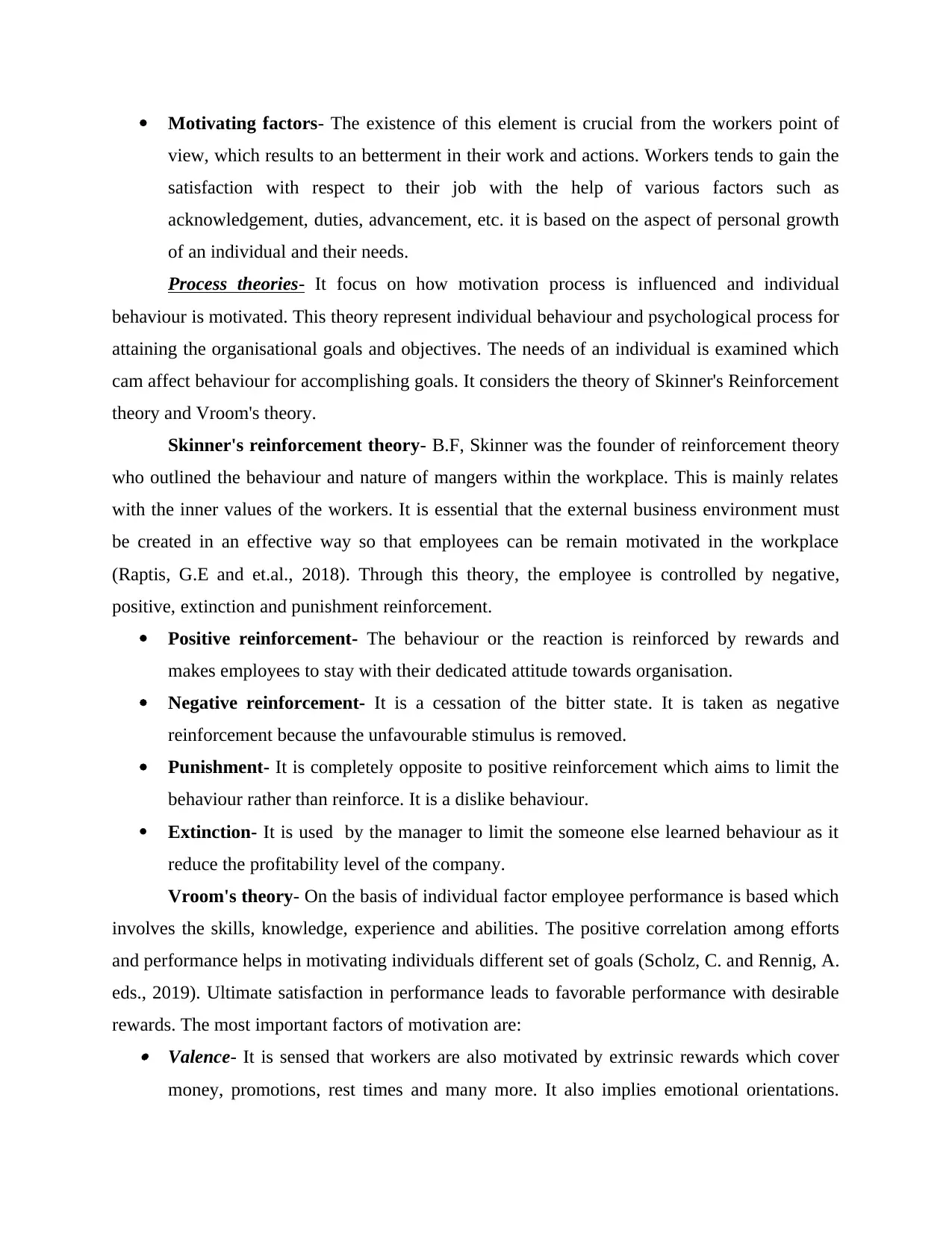
Motivating factors- The existence of this element is crucial from the workers point of
view, which results to an betterment in their work and actions. Workers tends to gain the
satisfaction with respect to their job with the help of various factors such as
acknowledgement, duties, advancement, etc. it is based on the aspect of personal growth
of an individual and their needs.
Process theories- It focus on how motivation process is influenced and individual
behaviour is motivated. This theory represent individual behaviour and psychological process for
attaining the organisational goals and objectives. The needs of an individual is examined which
cam affect behaviour for accomplishing goals. It considers the theory of Skinner's Reinforcement
theory and Vroom's theory.
Skinner's reinforcement theory- B.F, Skinner was the founder of reinforcement theory
who outlined the behaviour and nature of mangers within the workplace. This is mainly relates
with the inner values of the workers. It is essential that the external business environment must
be created in an effective way so that employees can be remain motivated in the workplace
(Raptis, G.E and et.al., 2018). Through this theory, the employee is controlled by negative,
positive, extinction and punishment reinforcement.
Positive reinforcement- The behaviour or the reaction is reinforced by rewards and
makes employees to stay with their dedicated attitude towards organisation.
Negative reinforcement- It is a cessation of the bitter state. It is taken as negative
reinforcement because the unfavourable stimulus is removed.
Punishment- It is completely opposite to positive reinforcement which aims to limit the
behaviour rather than reinforce. It is a dislike behaviour.
Extinction- It is used by the manager to limit the someone else learned behaviour as it
reduce the profitability level of the company.
Vroom's theory- On the basis of individual factor employee performance is based which
involves the skills, knowledge, experience and abilities. The positive correlation among efforts
and performance helps in motivating individuals different set of goals (Scholz, C. and Rennig, A.
eds., 2019). Ultimate satisfaction in performance leads to favorable performance with desirable
rewards. The most important factors of motivation are: Valence- It is sensed that workers are also motivated by extrinsic rewards which cover
money, promotions, rest times and many more. It also implies emotional orientations.
view, which results to an betterment in their work and actions. Workers tends to gain the
satisfaction with respect to their job with the help of various factors such as
acknowledgement, duties, advancement, etc. it is based on the aspect of personal growth
of an individual and their needs.
Process theories- It focus on how motivation process is influenced and individual
behaviour is motivated. This theory represent individual behaviour and psychological process for
attaining the organisational goals and objectives. The needs of an individual is examined which
cam affect behaviour for accomplishing goals. It considers the theory of Skinner's Reinforcement
theory and Vroom's theory.
Skinner's reinforcement theory- B.F, Skinner was the founder of reinforcement theory
who outlined the behaviour and nature of mangers within the workplace. This is mainly relates
with the inner values of the workers. It is essential that the external business environment must
be created in an effective way so that employees can be remain motivated in the workplace
(Raptis, G.E and et.al., 2018). Through this theory, the employee is controlled by negative,
positive, extinction and punishment reinforcement.
Positive reinforcement- The behaviour or the reaction is reinforced by rewards and
makes employees to stay with their dedicated attitude towards organisation.
Negative reinforcement- It is a cessation of the bitter state. It is taken as negative
reinforcement because the unfavourable stimulus is removed.
Punishment- It is completely opposite to positive reinforcement which aims to limit the
behaviour rather than reinforce. It is a dislike behaviour.
Extinction- It is used by the manager to limit the someone else learned behaviour as it
reduce the profitability level of the company.
Vroom's theory- On the basis of individual factor employee performance is based which
involves the skills, knowledge, experience and abilities. The positive correlation among efforts
and performance helps in motivating individuals different set of goals (Scholz, C. and Rennig, A.
eds., 2019). Ultimate satisfaction in performance leads to favorable performance with desirable
rewards. The most important factors of motivation are: Valence- It is sensed that workers are also motivated by extrinsic rewards which cover
money, promotions, rest times and many more. It also implies emotional orientations.
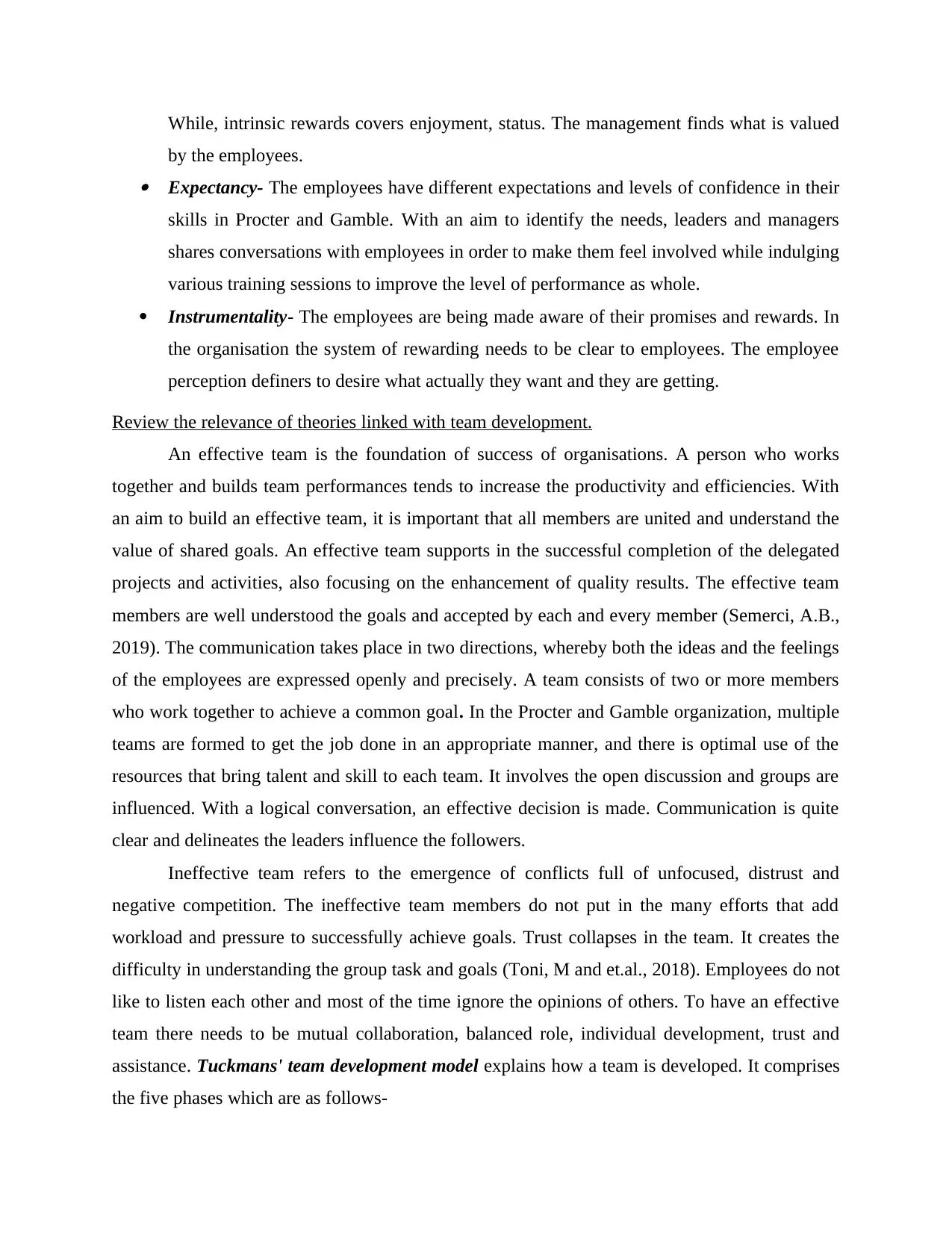
While, intrinsic rewards covers enjoyment, status. The management finds what is valued
by the employees. Expectancy- The employees have different expectations and levels of confidence in their
skills in Procter and Gamble. With an aim to identify the needs, leaders and managers
shares conversations with employees in order to make them feel involved while indulging
various training sessions to improve the level of performance as whole.
Instrumentality- The employees are being made aware of their promises and rewards. In
the organisation the system of rewarding needs to be clear to employees. The employee
perception definers to desire what actually they want and they are getting.
Review the relevance of theories linked with team development.
An effective team is the foundation of success of organisations. A person who works
together and builds team performances tends to increase the productivity and efficiencies. With
an aim to build an effective team, it is important that all members are united and understand the
value of shared goals. An effective team supports in the successful completion of the delegated
projects and activities, also focusing on the enhancement of quality results. The effective team
members are well understood the goals and accepted by each and every member (Semerci, A.B.,
2019). The communication takes place in two directions, whereby both the ideas and the feelings
of the employees are expressed openly and precisely. A team consists of two or more members
who work together to achieve a common goal. In the Procter and Gamble organization, multiple
teams are formed to get the job done in an appropriate manner, and there is optimal use of the
resources that bring talent and skill to each team. It involves the open discussion and groups are
influenced. With a logical conversation, an effective decision is made. Communication is quite
clear and delineates the leaders influence the followers.
Ineffective team refers to the emergence of conflicts full of unfocused, distrust and
negative competition. The ineffective team members do not put in the many efforts that add
workload and pressure to successfully achieve goals. Trust collapses in the team. It creates the
difficulty in understanding the group task and goals (Toni, M and et.al., 2018). Employees do not
like to listen each other and most of the time ignore the opinions of others. To have an effective
team there needs to be mutual collaboration, balanced role, individual development, trust and
assistance. Tuckmans' team development model explains how a team is developed. It comprises
the five phases which are as follows-
by the employees. Expectancy- The employees have different expectations and levels of confidence in their
skills in Procter and Gamble. With an aim to identify the needs, leaders and managers
shares conversations with employees in order to make them feel involved while indulging
various training sessions to improve the level of performance as whole.
Instrumentality- The employees are being made aware of their promises and rewards. In
the organisation the system of rewarding needs to be clear to employees. The employee
perception definers to desire what actually they want and they are getting.
Review the relevance of theories linked with team development.
An effective team is the foundation of success of organisations. A person who works
together and builds team performances tends to increase the productivity and efficiencies. With
an aim to build an effective team, it is important that all members are united and understand the
value of shared goals. An effective team supports in the successful completion of the delegated
projects and activities, also focusing on the enhancement of quality results. The effective team
members are well understood the goals and accepted by each and every member (Semerci, A.B.,
2019). The communication takes place in two directions, whereby both the ideas and the feelings
of the employees are expressed openly and precisely. A team consists of two or more members
who work together to achieve a common goal. In the Procter and Gamble organization, multiple
teams are formed to get the job done in an appropriate manner, and there is optimal use of the
resources that bring talent and skill to each team. It involves the open discussion and groups are
influenced. With a logical conversation, an effective decision is made. Communication is quite
clear and delineates the leaders influence the followers.
Ineffective team refers to the emergence of conflicts full of unfocused, distrust and
negative competition. The ineffective team members do not put in the many efforts that add
workload and pressure to successfully achieve goals. Trust collapses in the team. It creates the
difficulty in understanding the group task and goals (Toni, M and et.al., 2018). Employees do not
like to listen each other and most of the time ignore the opinions of others. To have an effective
team there needs to be mutual collaboration, balanced role, individual development, trust and
assistance. Tuckmans' team development model explains how a team is developed. It comprises
the five phases which are as follows-
⊘ This is a preview!⊘
Do you want full access?
Subscribe today to unlock all pages.

Trusted by 1+ million students worldwide
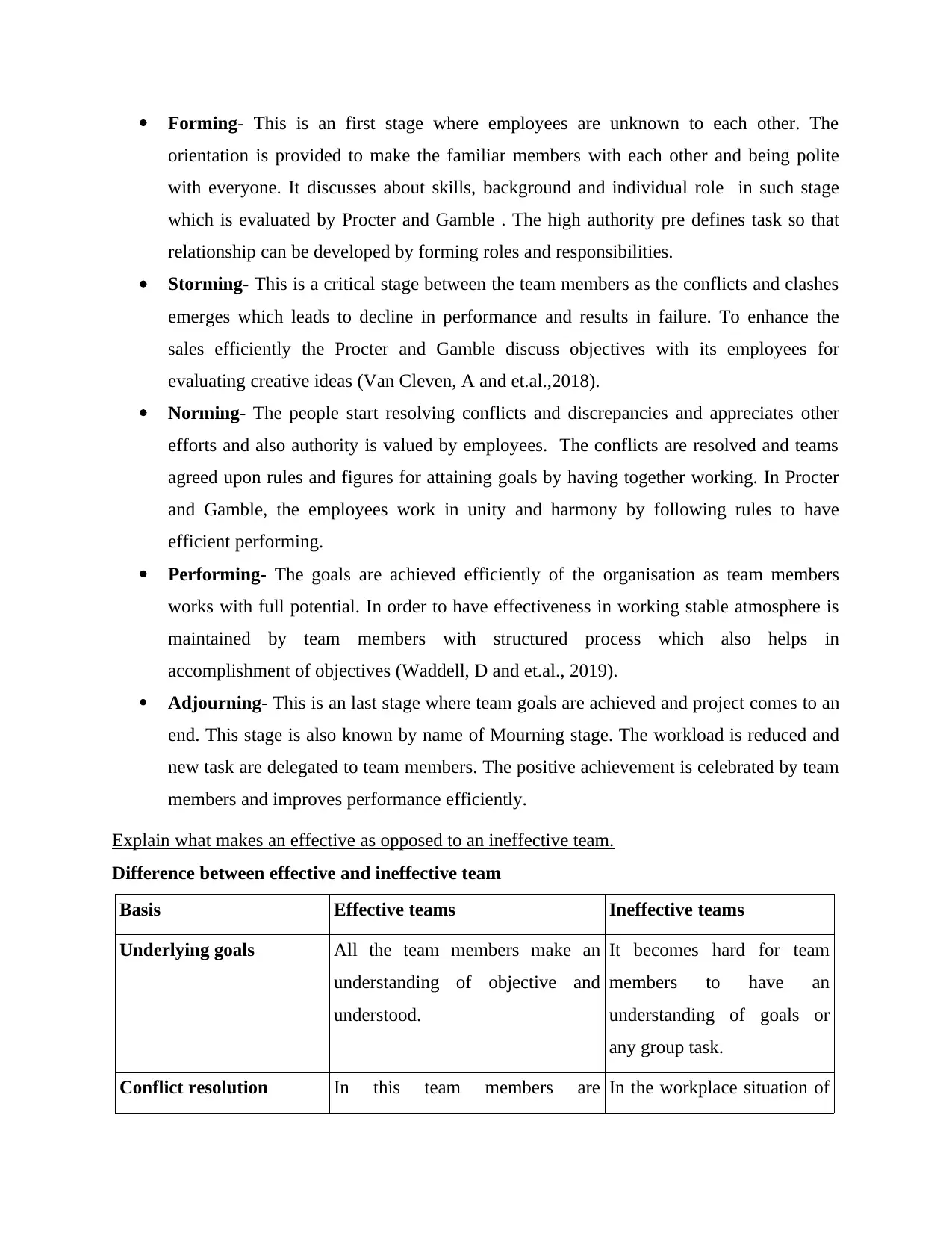
Forming- This is an first stage where employees are unknown to each other. The
orientation is provided to make the familiar members with each other and being polite
with everyone. It discusses about skills, background and individual role in such stage
which is evaluated by Procter and Gamble . The high authority pre defines task so that
relationship can be developed by forming roles and responsibilities.
Storming- This is a critical stage between the team members as the conflicts and clashes
emerges which leads to decline in performance and results in failure. To enhance the
sales efficiently the Procter and Gamble discuss objectives with its employees for
evaluating creative ideas (Van Cleven, A and et.al.,2018).
Norming- The people start resolving conflicts and discrepancies and appreciates other
efforts and also authority is valued by employees. The conflicts are resolved and teams
agreed upon rules and figures for attaining goals by having together working. In Procter
and Gamble, the employees work in unity and harmony by following rules to have
efficient performing.
Performing- The goals are achieved efficiently of the organisation as team members
works with full potential. In order to have effectiveness in working stable atmosphere is
maintained by team members with structured process which also helps in
accomplishment of objectives (Waddell, D and et.al., 2019).
Adjourning- This is an last stage where team goals are achieved and project comes to an
end. This stage is also known by name of Mourning stage. The workload is reduced and
new task are delegated to team members. The positive achievement is celebrated by team
members and improves performance efficiently.
Explain what makes an effective as opposed to an ineffective team.
Difference between effective and ineffective team
Basis Effective teams Ineffective teams
Underlying goals All the team members make an
understanding of objective and
understood.
It becomes hard for team
members to have an
understanding of goals or
any group task.
Conflict resolution In this team members are In the workplace situation of
orientation is provided to make the familiar members with each other and being polite
with everyone. It discusses about skills, background and individual role in such stage
which is evaluated by Procter and Gamble . The high authority pre defines task so that
relationship can be developed by forming roles and responsibilities.
Storming- This is a critical stage between the team members as the conflicts and clashes
emerges which leads to decline in performance and results in failure. To enhance the
sales efficiently the Procter and Gamble discuss objectives with its employees for
evaluating creative ideas (Van Cleven, A and et.al.,2018).
Norming- The people start resolving conflicts and discrepancies and appreciates other
efforts and also authority is valued by employees. The conflicts are resolved and teams
agreed upon rules and figures for attaining goals by having together working. In Procter
and Gamble, the employees work in unity and harmony by following rules to have
efficient performing.
Performing- The goals are achieved efficiently of the organisation as team members
works with full potential. In order to have effectiveness in working stable atmosphere is
maintained by team members with structured process which also helps in
accomplishment of objectives (Waddell, D and et.al., 2019).
Adjourning- This is an last stage where team goals are achieved and project comes to an
end. This stage is also known by name of Mourning stage. The workload is reduced and
new task are delegated to team members. The positive achievement is celebrated by team
members and improves performance efficiently.
Explain what makes an effective as opposed to an ineffective team.
Difference between effective and ineffective team
Basis Effective teams Ineffective teams
Underlying goals All the team members make an
understanding of objective and
understood.
It becomes hard for team
members to have an
understanding of goals or
any group task.
Conflict resolution In this team members are In the workplace situation of
Paraphrase This Document
Need a fresh take? Get an instant paraphrase of this document with our AI Paraphraser
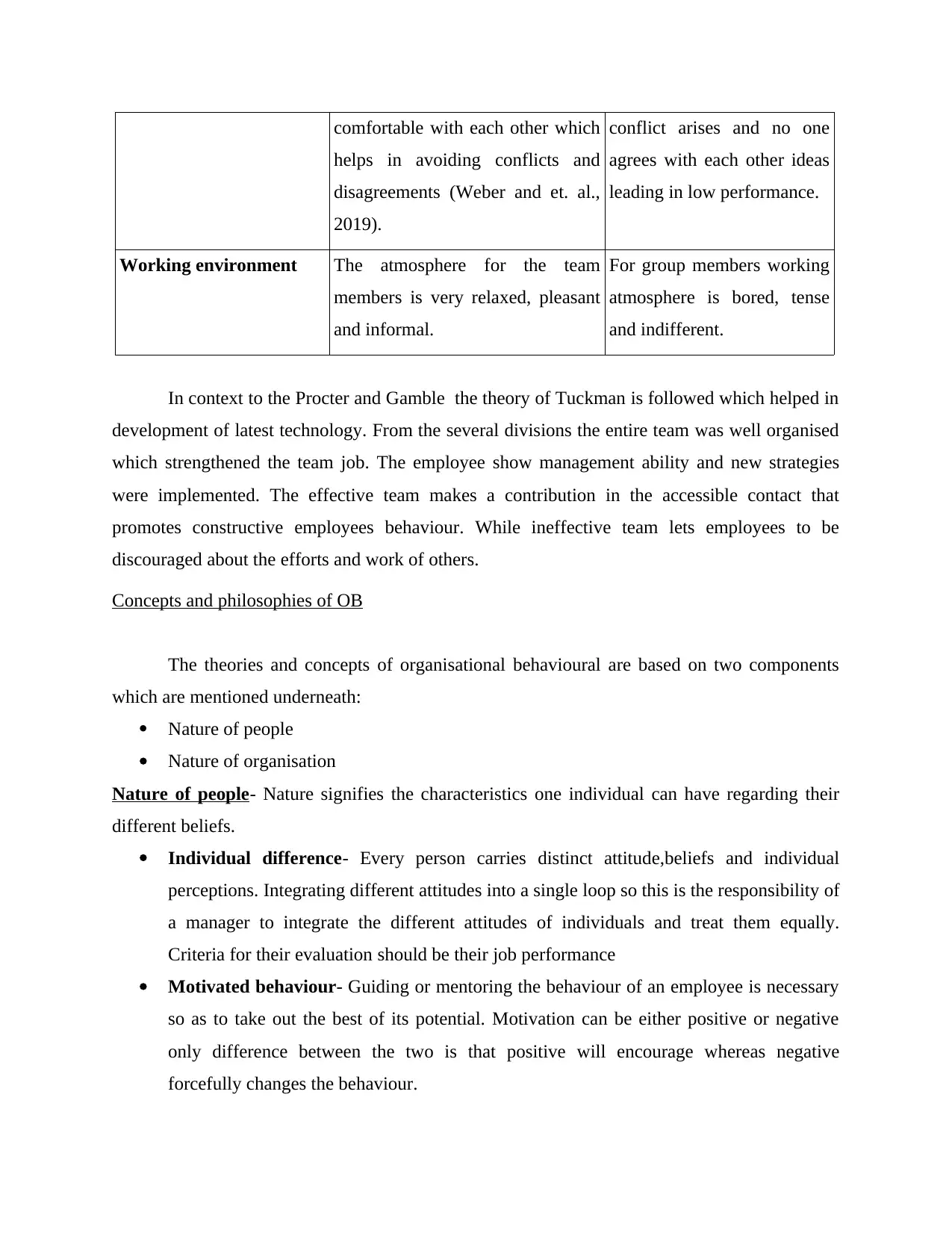
comfortable with each other which
helps in avoiding conflicts and
disagreements (Weber and et. al.,
2019).
conflict arises and no one
agrees with each other ideas
leading in low performance.
Working environment The atmosphere for the team
members is very relaxed, pleasant
and informal.
For group members working
atmosphere is bored, tense
and indifferent.
In context to the Procter and Gamble the theory of Tuckman is followed which helped in
development of latest technology. From the several divisions the entire team was well organised
which strengthened the team job. The employee show management ability and new strategies
were implemented. The effective team makes a contribution in the accessible contact that
promotes constructive employees behaviour. While ineffective team lets employees to be
discouraged about the efforts and work of others.
Concepts and philosophies of OB
The theories and concepts of organisational behavioural are based on two components
which are mentioned underneath:
Nature of people
Nature of organisation
Nature of people- Nature signifies the characteristics one individual can have regarding their
different beliefs.
Individual difference- Every person carries distinct attitude,beliefs and individual
perceptions. Integrating different attitudes into a single loop so this is the responsibility of
a manager to integrate the different attitudes of individuals and treat them equally.
Criteria for their evaluation should be their job performance
Motivated behaviour- Guiding or mentoring the behaviour of an employee is necessary
so as to take out the best of its potential. Motivation can be either positive or negative
only difference between the two is that positive will encourage whereas negative
forcefully changes the behaviour.
helps in avoiding conflicts and
disagreements (Weber and et. al.,
2019).
conflict arises and no one
agrees with each other ideas
leading in low performance.
Working environment The atmosphere for the team
members is very relaxed, pleasant
and informal.
For group members working
atmosphere is bored, tense
and indifferent.
In context to the Procter and Gamble the theory of Tuckman is followed which helped in
development of latest technology. From the several divisions the entire team was well organised
which strengthened the team job. The employee show management ability and new strategies
were implemented. The effective team makes a contribution in the accessible contact that
promotes constructive employees behaviour. While ineffective team lets employees to be
discouraged about the efforts and work of others.
Concepts and philosophies of OB
The theories and concepts of organisational behavioural are based on two components
which are mentioned underneath:
Nature of people
Nature of organisation
Nature of people- Nature signifies the characteristics one individual can have regarding their
different beliefs.
Individual difference- Every person carries distinct attitude,beliefs and individual
perceptions. Integrating different attitudes into a single loop so this is the responsibility of
a manager to integrate the different attitudes of individuals and treat them equally.
Criteria for their evaluation should be their job performance
Motivated behaviour- Guiding or mentoring the behaviour of an employee is necessary
so as to take out the best of its potential. Motivation can be either positive or negative
only difference between the two is that positive will encourage whereas negative
forcefully changes the behaviour.
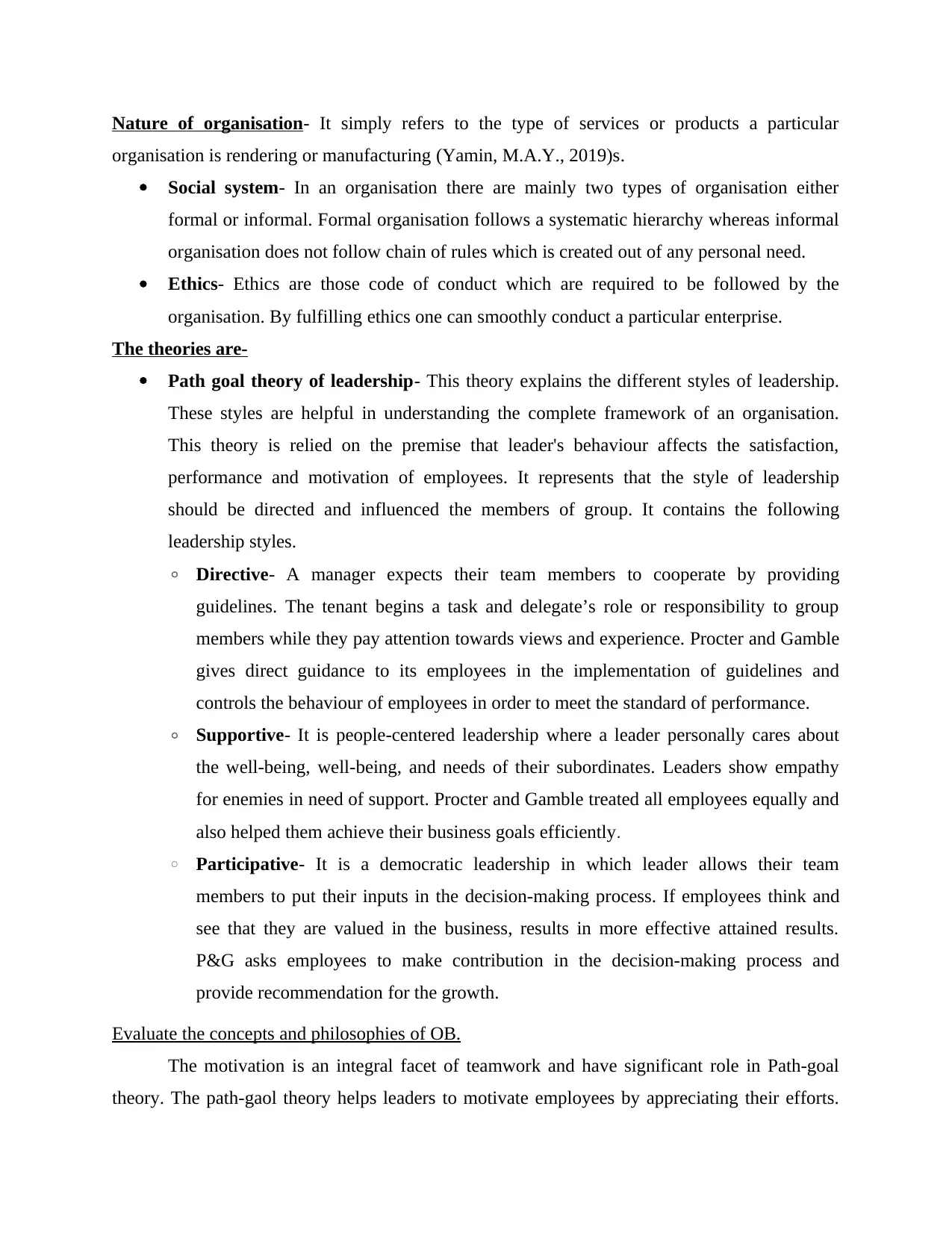
Nature of organisation- It simply refers to the type of services or products a particular
organisation is rendering or manufacturing (Yamin, M.A.Y., 2019)s.
Social system- In an organisation there are mainly two types of organisation either
formal or informal. Formal organisation follows a systematic hierarchy whereas informal
organisation does not follow chain of rules which is created out of any personal need.
Ethics- Ethics are those code of conduct which are required to be followed by the
organisation. By fulfilling ethics one can smoothly conduct a particular enterprise.
The theories are-
Path goal theory of leadership- This theory explains the different styles of leadership.
These styles are helpful in understanding the complete framework of an organisation.
This theory is relied on the premise that leader's behaviour affects the satisfaction,
performance and motivation of employees. It represents that the style of leadership
should be directed and influenced the members of group. It contains the following
leadership styles.
◦ Directive- A manager expects their team members to cooperate by providing
guidelines. The tenant begins a task and delegate’s role or responsibility to group
members while they pay attention towards views and experience. Procter and Gamble
gives direct guidance to its employees in the implementation of guidelines and
controls the behaviour of employees in order to meet the standard of performance.
◦ Supportive- It is people-centered leadership where a leader personally cares about
the well-being, well-being, and needs of their subordinates. Leaders show empathy
for enemies in need of support. Procter and Gamble treated all employees equally and
also helped them achieve their business goals efficiently.
◦ Participative- It is a democratic leadership in which leader allows their team
members to put their inputs in the decision-making process. If employees think and
see that they are valued in the business, results in more effective attained results.
P&G asks employees to make contribution in the decision-making process and
provide recommendation for the growth.
Evaluate the concepts and philosophies of OB.
The motivation is an integral facet of teamwork and have significant role in Path-goal
theory. The path-gaol theory helps leaders to motivate employees by appreciating their efforts.
organisation is rendering or manufacturing (Yamin, M.A.Y., 2019)s.
Social system- In an organisation there are mainly two types of organisation either
formal or informal. Formal organisation follows a systematic hierarchy whereas informal
organisation does not follow chain of rules which is created out of any personal need.
Ethics- Ethics are those code of conduct which are required to be followed by the
organisation. By fulfilling ethics one can smoothly conduct a particular enterprise.
The theories are-
Path goal theory of leadership- This theory explains the different styles of leadership.
These styles are helpful in understanding the complete framework of an organisation.
This theory is relied on the premise that leader's behaviour affects the satisfaction,
performance and motivation of employees. It represents that the style of leadership
should be directed and influenced the members of group. It contains the following
leadership styles.
◦ Directive- A manager expects their team members to cooperate by providing
guidelines. The tenant begins a task and delegate’s role or responsibility to group
members while they pay attention towards views and experience. Procter and Gamble
gives direct guidance to its employees in the implementation of guidelines and
controls the behaviour of employees in order to meet the standard of performance.
◦ Supportive- It is people-centered leadership where a leader personally cares about
the well-being, well-being, and needs of their subordinates. Leaders show empathy
for enemies in need of support. Procter and Gamble treated all employees equally and
also helped them achieve their business goals efficiently.
◦ Participative- It is a democratic leadership in which leader allows their team
members to put their inputs in the decision-making process. If employees think and
see that they are valued in the business, results in more effective attained results.
P&G asks employees to make contribution in the decision-making process and
provide recommendation for the growth.
Evaluate the concepts and philosophies of OB.
The motivation is an integral facet of teamwork and have significant role in Path-goal
theory. The path-gaol theory helps leaders to motivate employees by appreciating their efforts.
⊘ This is a preview!⊘
Do you want full access?
Subscribe today to unlock all pages.

Trusted by 1+ million students worldwide
1 out of 15
Related Documents
Your All-in-One AI-Powered Toolkit for Academic Success.
+13062052269
info@desklib.com
Available 24*7 on WhatsApp / Email
![[object Object]](/_next/static/media/star-bottom.7253800d.svg)
Unlock your academic potential
Copyright © 2020–2025 A2Z Services. All Rights Reserved. Developed and managed by ZUCOL.




